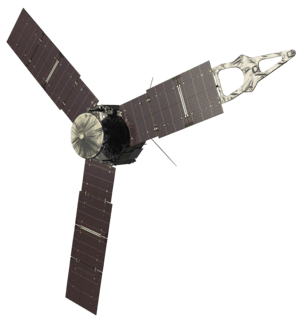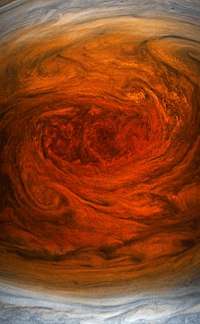Juno Radiation Vault
Juno Radiation Vault is a compartment inside the Juno spacecraft that houses much of the probe's electronics and computers, and is intended to offer increased protection of radiation to the contents as the spacecraft endures the radiation environment at planet Jupiter.[1] The Juno Radiation Vault is roughly a cube, with walls made of 1 cm thick (1/3 of an inch) titanium metal, and each side having an area of about a square meter (10 square feet).[2] The vault weights about 200 kg (500 lbs).[3] Inside the vault are the main command and data handling and power control boxes, along with 20 other electronic boxes.[2] The vault should reduce the radiation exposure by about 800 times, as the spacecraft is exposed to an anticipated 20 million rads of radiation[1] It does not stop all radiation, but significantly reduces it in order to limit damage to the spacecraft's electronics.[2]
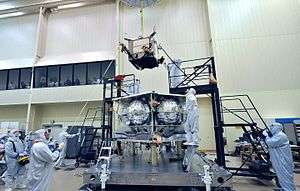

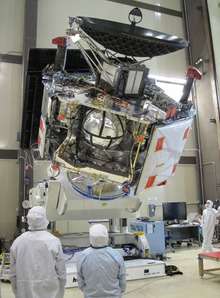

Summary
The vault has been compared being like "armor" or like a "tank", and the electronics within, like the spacecraft's "brain".[4] The power systems have been described as a "heart".[5]
Without its protective shield, or radiation vault, Juno’s brain would get fried on the very first pass near Jupiter
The vault is one of many features of the mission to help counter the high radiation levels near Jupiter, including an orbit that reduces time spent in the highest radiation regions, radiation-hardened electronics, and additional shielding on components.[3] The wires that lead out from the vault also have increased protection, they have a sheath of braided copper and stainless steel.[3] Some other components used tantalum metal for shielding in Juno, and while lead is known for its shielding effect it was found to be too soft in this application.[7] One reason that titanium was chosen over lead in this application was because titanium was better at handling launch stresses.[7]
Another shield part of the spacecraft is the Stellar Reference Unit (SRU), which has six times the shielding to prevent static forming on images due to radiation.[8] Juno is a space probe sent to Jupiter in 2011 and it entered orbit the night of July 4, 2016.[9] Juno is part of the New Frontiers program of NASA and was also built with some contributions by the Italian Space Agency (ASI).[9] After arriving at Jupiter in July 2016, the mission went into a 53-day orbit around the planet, and collected data using its suite of instrumentation in the late 2010s.[10]
Inside the vault
There are at least 20 different electronics boxes inside the vault, which is intended to reduce the amount of radiation they receive.[11]
Examples of components inside the vault:
- Command and data handling box[2]
- RAD750 microprocessor[12]
- Power and data distribution unit[2]
- Thermistor temperature sensors[13]
- UVS instrument electronics box[14]
- Waves instrument receivers and electronics box[15]
- Microwave Radiometer electronics[16][17][13]
- JADE instrument Ebox (or E-Box)[18]
JEDI and JunoCam do not have electronic boxes inside the vault.[19]
Technological relations
A Ganymede orbiter proposal also included a design for a Juno-like radiation vault.[20] However, because the radiation is less at Jupiter's moon Ganymede and the orbiter's path, the vault would not have to be as thick, all else being similar.[20] One reason the radiation is strong at Jupiter, but confined to certain belts, is because it is generated by ions and electrons trapped in areas as a result of Jupiter's magnetic field.[21] Jupiter's magnetosphere is about 20,000 times as strong as Earth's and is one of the items of study by Juno.[22] (see also Juno's Magnetometer (MAG) instrument)
Another spacecraft with radiation shields was Skylab, which needed a radiation shield over a borosilicate glass window to stop it darkening, and several film vaults.[23] There were five vaults for photographic film aboard the Skylab space station, and the largest weighed 1088 kg (2398 lb).[24][23] Juno is the first time a spacecraft has a titanium vault for its electronics however.[12] Radiation hardening in general is an important part of spacecraft design when it is required, and the main processor of Juno, the RAD750, has been used on other spacecraft where there are elevated radiation levels, and it is a radiation-hardened microprocessor.[12] For example, the RAD750 was also used on the Curiosity rover, launched November 26, 2011[25]
It was suggested by the publication Popular Science that the Europa Lander may use a radiation vault like the Juno Jupiter orbiter.[26]
Radiation infographic
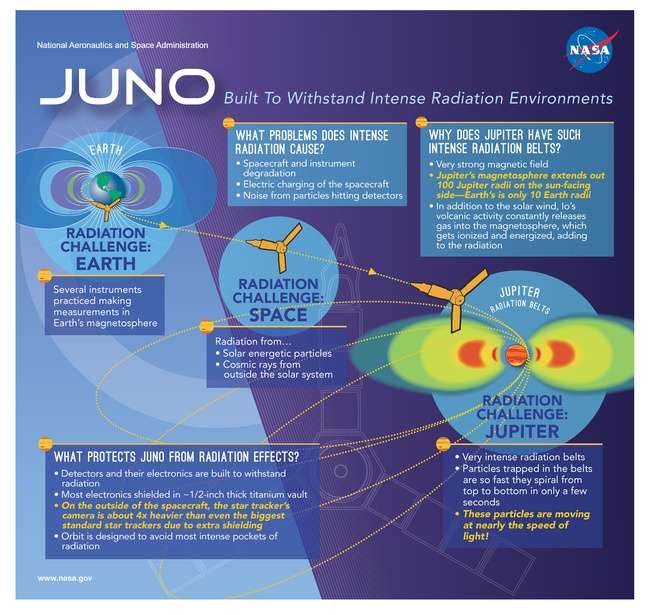
See also
- Galileo (spacecraft), NASA space probe to Jupiter 1989–2003 also endured high radiation
- Van Allen radiation belt (Earth's radiation belt)
- Europa Clipper (the next Jupiter mission under study during the 2010s)
- Radiation protection
References
- "Juno Probe Will Run Hellish Radiation Gauntlet at Jupiter Monday". Space.com. Retrieved 2017-01-08.
- "NASA – Juno Armored Up to Go to Jupiter". www.nasa.gov. Retrieved 2017-01-06.
- "NASA – Juno Armored Up to Go to Jupiter". www.nasa.gov. Retrieved 2017-01-08.
- "Juno's Armor". 2016-06-18.
- "How NASA's New Spacecraft Will Survive a Death-Defying Trip to Jupiter". Popular Mechanics. 2016-06-28. Retrieved 2017-01-08.
- Colorado Space News – Juno’s Armor
- "Juno's Armor | Colorado Space News". www.coloradospacenews.com. 2016-06-18. Retrieved 2017-01-06.
- Science, Sarah Lewin 2018-12-13T12:08:08Z; Astronomy. "Auroras, Lightning and Rings of Jupiter Amaze in Surprising NASA Juno Photos". Space.com. Retrieved 2019-12-09.
- "The 10 Biggest Spaceflight Stories of 2016". Space.com. Retrieved 2017-01-08.
- "NASA's Juno Prepares to Jump Jupiter's Shadow". NASA/JPL. Retrieved 2019-12-09.
- "Setting up Juno's Radiation Vault". 2016-06-24.
- Scharf, Caleb A. "The Jupiter Vault". Scientific American Blog Network. Retrieved 2017-01-06.
- "Instrument Overview – Juno". spaceflight101.com. Retrieved 2017-01-06.
- Pingree, P.; Janssen, M.; Oswald, J.; Brown, S.; Chen, J.; Hurst, K.; Kitiyakara, A.; Maiwald, F.; Smith, S. (2008-03-01). Microwave Radiometers from 0.6 to 22 GHz for Juno, A Polar Orbiter around Jupiter. 2008 IEEE Aerospace Conference. pp. 1–15. CiteSeerX 10.1.1.473.3408. doi:10.1109/AERO.2008.4526403. ISBN 978-1-4244-1487-1.
- Key and Driving Requirements for the Juno Payload Suite of Instruments
- McComas, D. J.; Alexander, N.; Allegrini, F.; Bagenal, F.; Beebe, C.; Clark, G.; Crary, F.; Desai, M. I.; Santos, A. De Los (2013-05-25). "The Jovian Auroral Distributions Experiment (JADE) on the Juno Mission to Jupiter". Space Science Reviews. 213 (1–4): 547–643. Bibcode:2017SSRv..213..547M. doi:10.1007/s11214-013-9990-9. ISSN 0038-6308.
- "Instrument Overview – Juno". spaceflight101.com. Retrieved 2017-01-08.
- "How NASA's New Spacecraft Will Survive a Death-Defying Trip to Jupiter". Popular Mechanics. 2016-06-28. Retrieved 2017-01-06.
- "How The Juno Spacecraft Will Survive Jupiter's Devastating Radiation". Popular Science. Retrieved 2017-01-06.
- "Radiation problems associated with Skylab". January 1972.
- NASA Launches Most Capable and Robust Rover to Mars
- "Here's what NASA's Europa lander could look like". Popular Science. Retrieved 2017-02-15.
External links
| Wikimedia Commons has media related to Juno (spacecraft). |
